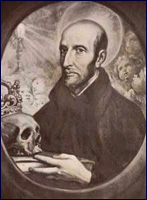General from 1565 to 1572
The Duke of Gandia in Spain, who was destined to become the third General of the Jesuits, was born in Gandia, Spain, on October 28, 1510 to Juan and Juana of the high nobility in those times of Spain's glory under Charles V and Philip II. Elizabeth was on the throne of England and Shakespeare was blossoming as one of the greatest playwrights of all time. The Third Duke had inherited large estates and numerous honors which his illustrious forebears, both famous and infamous, through their good services bequeathed him. Francis' mother Donna Juana was the granddaughter of Ferdinand V, King of Aragon and though the Borgia line was full of scamps and scoundrels, the father and mother of Francis were good Christians. Francis' tutor was an ecclesiastic chosen by his mother and the boy grew up pious, though with all the skills expected of the scion of a noble family. He could not only ride and fence with great skill, but one of his favorite sports was falconry. Besides physical sports, he was a competent musician and as a boy gave little sermons to the good Poor Clare Sisters of which his aunts were members in the local convent. He was intelligent in his studies and was a sportsman with many skills. When he was ten his mother died and he was sent from one relative to the other to polish his character. They all wanted some part in the education of this heir to the Dukedom of Gandia. For the beginning of his royal attachments he became a page at the Court of Catherine, the sister of Charles V. Because of his outstanding pedigree he contracted a marriage with Leonor de Castro, the favorite Lady-in-waiting to the Empress. Despite the fact that it was, more or less, an arranged marriage, Francis was genuinely in love with Leonor by whom he had eight sons. When the Empress Isabella, in whose service he found himself, died he was chosen by her Will for the honor of accompanying her remains to her burial. On June 26, 1539 he was appointed Viceroy of Catalonia and at his father's death on December 17, 1542 he claimed his inheritance and rights as successor to the Dukedom. During his term in Barcelona he first came into contact with the Jesuits and liked what he saw. He built for them a College which Pope Paul IV elevated to the rank of a university in 1547. In 1546 his wife suddenly died (poisoned!!) and Francis, by this time a close friend, admirer, and collaborator of the Jesuits of Catalonia, secretly petitioned admittance into the Society. He made his solemn profession on February 1, 1548 but continued to wear secular dress in order to administer his estates and to settle the affairs of his children. He studied Theology at the new University he had founded and received a Doctor of Divinity degree on August 20, 1550. He immediately undertook a pilgrimage to Rome in order to arrange with Ignatius for his open and official entrance into the Society. On May 23, 1551 he was ordained at Oñate and said his first Mass at Loyola on August 1. He preached and taught catechism in the Basque province during which he performed severe corporal penances. He remained in the service of the king and assisted Queen Juana in her last illness. After the queen had died and Charles had abdicated to retire to a monastery, he often called upon Francis for advice not only on spiritual matters, but also on matters of State. Borgia was eventually called to Rome by Pope Paul IV in 1561 and three years later was appointed Vicar General and Assistant General of the Jesuits for Spain and Portugal. When Diego Lainez died in 1565 Borgia was chosen General on July 2 of that year at the Society's Second General Congregation by 23 votes out of 31. During his 7 years as General, the Society continued to grow. He established new missions in the New World. He re-founded the German College in Rome to prepare missionaries to return and re-evangelize their own country, in great part lost to the Protestants. Other Colleges were established in France and Poland and the Roman College received his special consideration in the appointment of professors. The Gesú Church and the Novitiate of St. Andrea just behind the Quirinal Palace were established. He died on September 30, 1572 and his remains, like those of his predecessor, were placed in the little church of the Curia. At the time of his beatification, his nephew, the Duke of Lerma, petitioned to have his body sent to Spain and interred along with Lainez in Madrid. The request was granted, and the two Generals were entombed side by side in the Jesuit Church, but both remains met the same fate when the Jesuit Church was burned to the ground in the political unrest of the early 1930s. His few ashes which remained were then re-interred in the south wall of the present Jesuit Church and identified by a plaque giving the important dates and the office he had held in the Society for 7 years.
|
